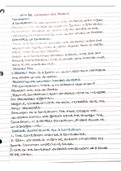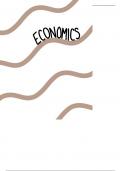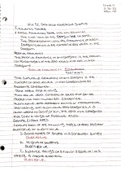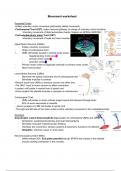Please note that Assignment 03 consists of Section A and Section B.
ASSIGNMENT 3 MARKS BREAKDOWN
SECTION A 15 MARKS
SECTION B 30 MARKS
TOTAL 45 MARKS
SECTION A: QUESTION 1
As a fourth-year student, you need to demonstrate a certain degree of professionalism and
academic writing skills. In other words, you must present your work and reference all the
sources you consulted. You should use the Harvard referencing method - it is uploaded under
the resources SCH4801 module site. To be able to answer question 1, you will need news
articles and academic sources together with the prescribed book. Therefore, supplement your
understanding of the formation and structuring of the public supply chain management
challenges with additional relevant sources. Here are a few suggestions for searching for
relevant academic sources:
- Consult the Unisa library:
https://www.unisa.ac.za/sites/corporate/default/Library
- Search for full-access articles on ScienceDirect:
https://www.sciencedirect.com/
- Search on Google Scholar
Instructions and guidelines for answering Question 1
Read answers from the AI tool below and answer the questions that followed.
Pay attention to the marks allocated to a particular question, as this will guide you in
terms of how much time you should spend on the question and the amount of detail
required. Then, structure your answer using headings and bullets and underlining (or
highlighting) the important elements.
In this assignment, you must base your answer on the relevant theory appropriate to the
circumstances described in the ‘answers by the AI Tool’. Next, justify the part of the theory
you select about its suitability with relevant academic sources or news articles. You will be
penalised if you copy and paste the theory from your prescribed book or any other
sources.
Please note that there is no need for an introduction and conclusion. Instead, you need to
write down the number and the question, followed by your answer.
Sensitivity: Internal / Non-Personal Data
, Example:
Question 1. Monopoly is a market structure where only one supplier can provide a
product or service. Do you agree with this statement? {1 mark}. Make use of a source
as motivation for your answer. [Please note that you need to use a different source
than your prescribed book]
Yes, I agree, as the monopoly market structure is characterised by a single seller selling
unique products in the market. In a monopoly market, the sellers face no competition, as
they are the sole seller of goods, with no substitutes. They enjoy the power of setting the
price of their goods (Badenhorst -Weiss, Cilliers, Dlamini, & Ambe, 2017)
Or
Yes, I agree. According to authors Handfield, Giunipero, Patterson & Monczka (2021), a
monopoly market structure …..
Or
Yes, I agree. Author Van Weele (2018) echoed that a monopoly market structure is where
only one supplier provides……
Your answers should not exceed three pages.
Read the following and answer the questions that followed.
The following question was posted to an AI Tool on 6 July 2023: Describe and discuss eight
supply chain challenges in the South African public sector.
Answer by the AI Tool:
Supply chain challenges in the South African public sector can significantly impact the
efficient delivery of goods and services. Here are eight key challenges that are commonly
faced in this context:
1. Procurement inefficiencies: The public sector often struggles with inefficient
procurement processes, including lengthy bidding procedures, lack of transparency, and
inadequate supplier evaluation mechanisms. These challenges can lead to delays in
acquiring necessary goods and services.
2. Limited supplier base: The South African public sector sometimes faces challenges in
finding a diverse and capable pool of suppliers. Limited competition among suppliers can
result in higher prices, reduced quality, and limited innovation in the delivery of goods and
services.
3. Corruption and fraud: Corruption and fraud remain persistent challenges in the South
African public sector supply chain. Unethical practices such as bribery, kickbacks, and
collusion can undermine the integrity of procurement processes, leading to financial losses
and compromised service delivery.
4. Infrastructure constraints: Deficient transportation, logistics, and warehousing
infrastructure can hinder the smooth flow of goods and services across the supply chain.
Sensitivity: Internal / Non-Personal Data
ASSIGNMENT 3 MARKS BREAKDOWN
SECTION A 15 MARKS
SECTION B 30 MARKS
TOTAL 45 MARKS
SECTION A: QUESTION 1
As a fourth-year student, you need to demonstrate a certain degree of professionalism and
academic writing skills. In other words, you must present your work and reference all the
sources you consulted. You should use the Harvard referencing method - it is uploaded under
the resources SCH4801 module site. To be able to answer question 1, you will need news
articles and academic sources together with the prescribed book. Therefore, supplement your
understanding of the formation and structuring of the public supply chain management
challenges with additional relevant sources. Here are a few suggestions for searching for
relevant academic sources:
- Consult the Unisa library:
https://www.unisa.ac.za/sites/corporate/default/Library
- Search for full-access articles on ScienceDirect:
https://www.sciencedirect.com/
- Search on Google Scholar
Instructions and guidelines for answering Question 1
Read answers from the AI tool below and answer the questions that followed.
Pay attention to the marks allocated to a particular question, as this will guide you in
terms of how much time you should spend on the question and the amount of detail
required. Then, structure your answer using headings and bullets and underlining (or
highlighting) the important elements.
In this assignment, you must base your answer on the relevant theory appropriate to the
circumstances described in the ‘answers by the AI Tool’. Next, justify the part of the theory
you select about its suitability with relevant academic sources or news articles. You will be
penalised if you copy and paste the theory from your prescribed book or any other
sources.
Please note that there is no need for an introduction and conclusion. Instead, you need to
write down the number and the question, followed by your answer.
Sensitivity: Internal / Non-Personal Data
, Example:
Question 1. Monopoly is a market structure where only one supplier can provide a
product or service. Do you agree with this statement? {1 mark}. Make use of a source
as motivation for your answer. [Please note that you need to use a different source
than your prescribed book]
Yes, I agree, as the monopoly market structure is characterised by a single seller selling
unique products in the market. In a monopoly market, the sellers face no competition, as
they are the sole seller of goods, with no substitutes. They enjoy the power of setting the
price of their goods (Badenhorst -Weiss, Cilliers, Dlamini, & Ambe, 2017)
Or
Yes, I agree. According to authors Handfield, Giunipero, Patterson & Monczka (2021), a
monopoly market structure …..
Or
Yes, I agree. Author Van Weele (2018) echoed that a monopoly market structure is where
only one supplier provides……
Your answers should not exceed three pages.
Read the following and answer the questions that followed.
The following question was posted to an AI Tool on 6 July 2023: Describe and discuss eight
supply chain challenges in the South African public sector.
Answer by the AI Tool:
Supply chain challenges in the South African public sector can significantly impact the
efficient delivery of goods and services. Here are eight key challenges that are commonly
faced in this context:
1. Procurement inefficiencies: The public sector often struggles with inefficient
procurement processes, including lengthy bidding procedures, lack of transparency, and
inadequate supplier evaluation mechanisms. These challenges can lead to delays in
acquiring necessary goods and services.
2. Limited supplier base: The South African public sector sometimes faces challenges in
finding a diverse and capable pool of suppliers. Limited competition among suppliers can
result in higher prices, reduced quality, and limited innovation in the delivery of goods and
services.
3. Corruption and fraud: Corruption and fraud remain persistent challenges in the South
African public sector supply chain. Unethical practices such as bribery, kickbacks, and
collusion can undermine the integrity of procurement processes, leading to financial losses
and compromised service delivery.
4. Infrastructure constraints: Deficient transportation, logistics, and warehousing
infrastructure can hinder the smooth flow of goods and services across the supply chain.
Sensitivity: Internal / Non-Personal Data











